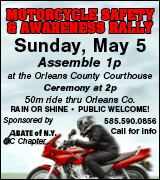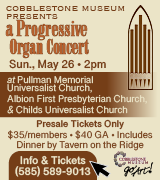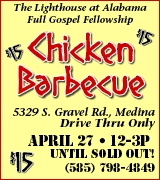Rochester unveils many statues of Frederick Douglass in honor of his 200th birthday
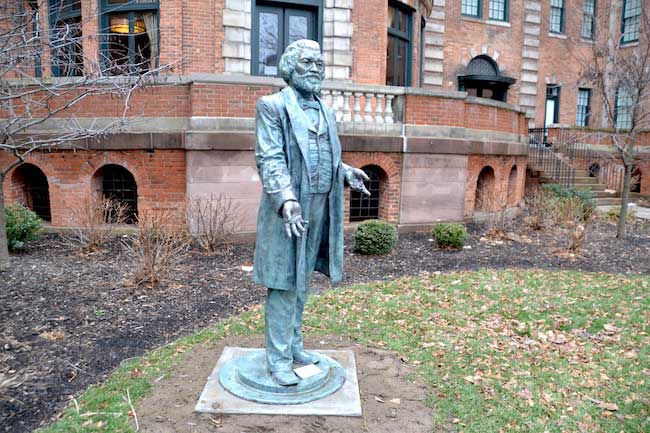
Photos by Tom Rivers
ROCHESTER – The City of Rochester last year unveiled 13 statues in honor of Frederick Douglass during the 200th anniversary of his birth.
These photos of one of the Douglass statues were taken on Jan. 8. This is at 300 Alexander St., which is near the site of Douglass’s first home in Rochester at 297 Alexander St.
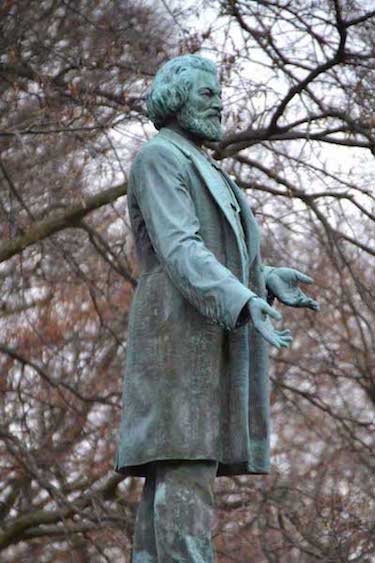
File photo by Tom Rivers: The original bronze statue at Highland Park was created by Stanley Edwards and is up high on a pedestal.
These statues are very similar to the one at Highland Park in Rochester. That statue, unveiled in 1899, was the first statue erected in the country in honor of an African-American.
Douglass was born a slave in Maryland in 1818. He escaped the South at age 21 and moved to Rochester in 1847. He stayed for 25 years.
The human rights advocate was a prominent speaker, editor and author, taking on many causes, including women’s suffrage. (He attended the first women’s rights convention at Seneca Falls in 1848, the only African American male present, and delivered a speech that helped sway support for the suffrage resolution.)
“At any rate, seeing that the male government of the world have failed, it can do no harm to try the experiment of a government by man and woman united…” Douglass said then.
The monument at Highland Park includes excerpts from other famous Douglass speeches:
• “The best defense of free American institution is the hearts of the American people themselves.”
• “One with God is a majority.”
• “I know of no rights of race superior to the rights of humanity.”
• “Men do not live by bread alone; so with nations, they are not saved by art, but by honesty, not by gilded splendors of wealth but by the hidden treasure of manly virtue, not by the multitudinous gratification of the flesh, but by the celestial guidance of the spirit.”
• “I know of no soil better adapted to the growth of reform than American soil. I know of no country where the conditions for effecting great changes in the settled order of things, for the development of right ideas of liberty and humanity are more favorable than here in these United States.”
The new statues of Douglass were created by Rochester sculptor Olivia Kim. The statues are placed at sites around the city that are significant in Douglass’s life and his work as an abolitionist.
Douglass, as a crusader, made Rochester a focal point of the abolitionist movement. He published the North Star newspaper in Rochester and coordinated Underground Railroad efforts in the area.
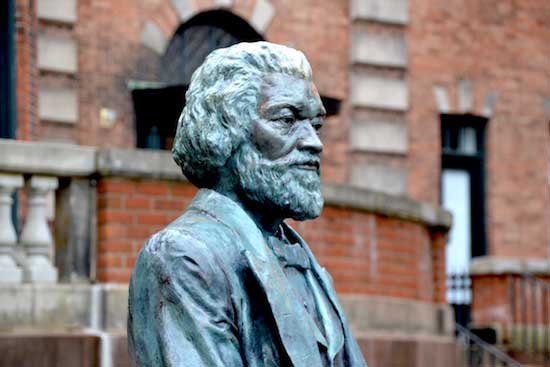
Frederick Douglass was one of the most famous Americans during the 19th Century.
Douglass lived in the city until an unexplained fire at his home. He then moved to Washington where he worked for the Garfield and Harrison administrations.
He died in 1895 and Rochester moved to honor him with the bronze statue. It was created by sculptor Stanley Edwards, who used Douglass’s son Charles as a model.
When it was unveiled in 1899 in front of New York Central Train Station, it was the first statue dedicated to a black man. The dedication ceremony for the Douglass memorial was attended by 10,000 people, including Theodore Roosevelt, who was then New York’s governor.
The statue was moved to Highland Park in 1941. Rochester officials didn’t think the spot by the train station at the corner of St. Paul Street and Central Avenue was a fitting location for one of the city’s most respected residents. That site was noisy and grimy.
The new statues were part of the Frederick Douglass Bicentennial Commemoration. The project aimed to better connect Douglass to the community, to bring him down to the ground where more people could interact with the statues.
Kim, the artist who created the new sculptures, softened Douglass’s stern look and tried to present him in a more relaxed pose.
Kim used the hands of Kenneth B. Morris Jr., the great-great-great-grandson of Frederick Douglass, as a model for the new Douglass statues.
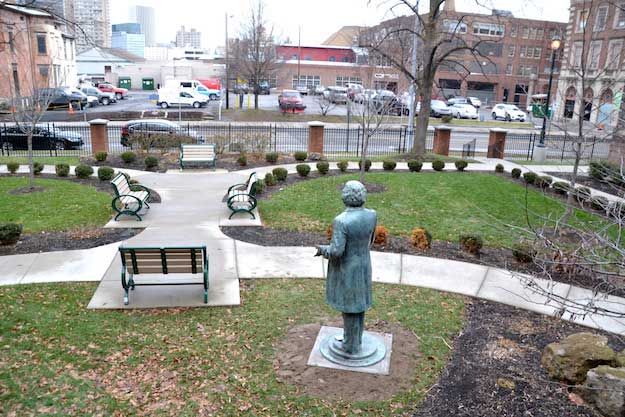
This new Douglass statue is at 300 Alexander St.
You can see new Douglass statues at:
• 25 East Main St., where Douglass published The North Star
• 42 Favor St., the former site of the AME Zion Church which is the original site where Douglass published his newspaper and also a stop on the Underground Railroad
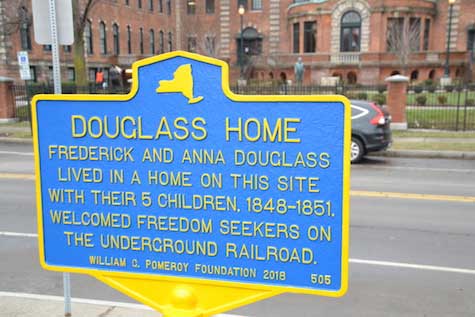
A historical marker was erected last year across from 300 Alexander St., where there is a new Frederick Douglass statue.
• 999 South Ave., the site of the Douglass family farm (now a school)
• 50 Plymouth Avenue North, formerly the Central Presbyterian Church and now Hochstein School of Music and Dance, where mourners gathered for Douglass’s funeral
• The intersection of Central Avenue and St. Paul Street, where the original statue from 1899 was located before moving to Highland Park
• Corinthian Street, where Douglass delivered his renown Fourth of July speech
• 300 Alexander Street, near the site of Douglass’s first home in Rochester at 297 Alexander St.
• Intersection of Alexander Street and Tracy Street, which was the site of the Seward School attended by Douglass’s children.
• Kelsey’s Landing in Maplewood Park – Underground Railroad departure point
• 1133 Mount Hope Ave. at Mt. Hope Cemetery, burial site for Douglass and his family membes
• Washington Square Park which is the site of the Civil War “Soldiers and Sailors” monument
• University of Rochester Rush Rhees Library, which commemorates Douglass’s work in Rochester
• SUNY Rochester Educational Opportunity Center for The College at Brockport on Chestnut Street, which celebrates Douglass’s commitment to education
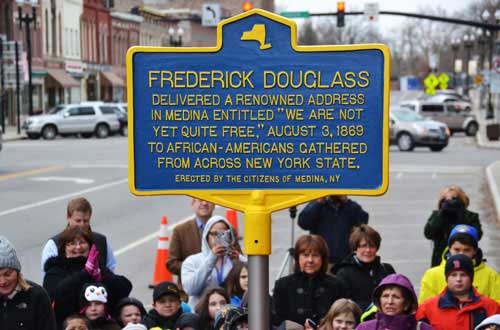
Medina unveiled a historical marker for Douglass on Main Street in April 2015.
The Orleans Renaissance Group and Village of Medina on April 25, 2015 unveiled a historical marker in honor of Douglass on Main Street, in front of the Knights of Columbus.
The historical marker unveiled today on Main Street in Medina highlights two speeches he gave in Medina.
In 1849, Douglass delivered a speech in Medina at the former Methodist Episcopal Church on Main Street (the current Fuller block, home of Main Street Appliance). He also visited Medina in 1869 and gave a celebratory address for Emancipation entitled “We are not yet quite free.” That event on Aug. 3 was attended by African-Americans from throughout the state.
During the marker’s unveiling on April 25, 2015, Chris Busch, the ORG chairman, addressed the group with these closing comments:
“Let these words here, cast in iron, now and for all time, give us pause to remember our intrepid and beloved countryman, Frederick Douglass, and our forebears who stood with him in the cause of freedom and emancipation, in dark and dangerous times, when few had the courage to do so. Let us with this marker never forget their courage, and solemnly pledge to preserve their legacy for all generations.”















